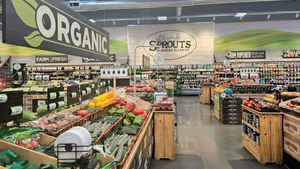Report: Americans are scaling back their Thanksgivings this yearReport: Americans are scaling back their Thanksgivings this year
Grocery prices are up 26% overall from what they were in the pre-pandemic, pre-inflationary days
November 19, 2024

A new report indicates that this year, Americans may find more price concerns and fewer people around the dining room table.
The report, from Deloitte, says that grocery inflation has returned to more historical norms, but grocery prices are up 26% overall from what they were in the pre-pandemic, pre-inflationary days of January 2020. A 16-pound turkey, for instance, cost 31% more last year than before the pandemic. Pumpkin pie mix and pie shells set shoppers back 34% and 39% more, respectively. Stuffing was up 41% and dinner rolls cost 54% more.
Despite the high costs, some three in four Americans surveyed (75%) say they plan to be part of a Thanksgiving gathering or celebration this year (16% still weren’t sure). For many of those hosting, the event is more than just a party. About 8 in 10 say it is an important part of their personal tradition or culture. That reverence brings with it some resilience in the face of difficulties like prices. However, the higher costs could put a damper on this year’s celebration, the report says.
Forty-four percent of those hosting are concerned about the cost of the event. And, 3 in 10 hosts surveyed are leaving more friends or relatives off the invite list this year.
Age demographics also matter, and Gen Z hosts seem especially affected this year. In our survey, they were the most likely to report concerns about costs (61%) and the most likely to reduce their guest lists (49%). Gen Zers’ disposition could be partly due to an income effect, Deloitte writes, as younger people tend to make less income, but it may have something to do with more limited experience hosting. Hosting as a priority is less a part of Gen Z traditions (10 percentage points lower than other generations), many of which are likely still being established in younger households.
Three in 10 respondents (30%) say they will serve or eat a less fancy meal this year featuring lower-cost dishes. Almost half of hosts (47%) plan to ask their guests outright to bring something. And indeed, 92% of guests do plan to bring something. On average, they plan to spend just over US$47 on their offering.
More potluck-style gatherings might create a stronger sense of community for hosts and guests alike, but some will be left out entirely this Thanksgiving. Almost one in 10 surveyed (9%) already know they aren’t attending a gathering. Of those, 40% say they are not celebrating with others due to the higher food costs, 35% cite more general financial concerns, and 26% say they are scheduled to work during the holiday.
Some retailers are leaning into holiday meal price concerns by offering specially discounted meal packages aiming to keep the cost below a certain threshold, like US$5–7 per person. It remains to be seen if those types of discounts will stretch into 2025 occasions or how much food and beverage company suppliers will be asked to share in the discounting.
Either way, consumers will have to continue grappling with the cost of food after Thanksgiving. The Deloitte food frugality index (FFI) tracks a basket of consumer tradeoffs and economizing behaviors over time, with higher numbers indicating consumers are tightening their purse strings. The latest data, which stems from a survey of 2,000 respondents, reflects the following trade-offs made by surveyed consumers:
29% purchased mostly store brands
24% purchased mostly low-cost ingredients
24% purchased mostly lower-cost meats and cuts
The findings also spotlight consumers’ other economizing behaviors:
35% saved by reducing at-home food waste
25% only bought essentials
19% bought less than they wanted
There is a silver lining in the data, the report states. The FFI index just hit its lowest point since the index launched just over two years ago, seven percentage points below the baseline, which indicates consumers are becoming less frugal with their spending and could be a sign of growing consumer confidence. If this trend continues, by next Thanksgiving, there could be a shift.
About the Author
You May Also Like






